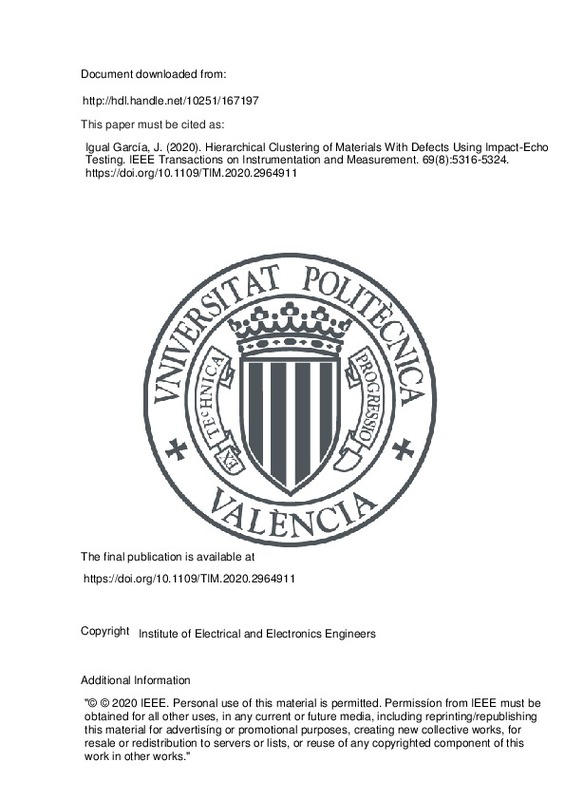JavaScript is disabled for your browser. Some features of this site may not work without it.
Buscar en RiuNet
Listar
Mi cuenta
Estadísticas
Ayuda RiuNet
Admin. UPV
Hierarchical Clustering of Materials With Defects Using Impact-Echo Testing
Mostrar el registro sencillo del ítem
Ficheros en el ítem
| dc.contributor.author | Igual García, Jorge
|
es_ES |
| dc.date.accessioned | 2021-06-03T03:31:40Z | |
| dc.date.available | 2021-06-03T03:31:40Z | |
| dc.date.issued | 2020-01-10 | es_ES |
| dc.identifier.issn | 0018-9456 | es_ES |
| dc.identifier.uri | http://hdl.handle.net/10251/167197 | |
| dc.description | "© © 2020 IEEE. Personal use of this material is permitted. Permissíon from IEEE must be obtained for all other uses, in any current or future media, including reprinting/republishing this material for advertisíng or promotional purposes, creating new collective works, for resale or redistribution to servers or lists, or reuse of any copyrighted component of this work in other works." | es_ES |
| dc.description.abstract | [EN] Signals obtained from impact-echo techniques can be used to detect and classify the defects in damaged materials. The defects change the wave propagation between the impact and the sensors producing particular spectrum elements, which define the feature vector. We propose a hierarchical clustering method that models the feature vector as a mixture of Gaussians (MoG) for every class and then merges different clusters using as a distance measure the symmetric Kullback-Leibler (KL) divergence. Since there is no closed-form solution to the KL divergence between MoGs, some approximations are introduced. We apply the hierarchical clustering algorithms to the signals obtained from real specimens made of aluminum alloy. The samples are classified into four classes according to the state: homogeneous (no defect), one hole, one crack, and multiple defects. We compare the performance of different approximations and discuss the dendrograms that are obtained. Similar kinds of defects are clustered first, and more importantly, the high-level hierarchy is able to distinguish between the defective and nondefective materials. | es_ES |
| dc.language | Inglés | es_ES |
| dc.publisher | Institute of Electrical and Electronics Engineers | es_ES |
| dc.relation.ispartof | IEEE Transactions on Instrumentation and Measurement | es_ES |
| dc.rights | Reserva de todos los derechos | es_ES |
| dc.subject | Testing | es_ES |
| dc.subject | Clustering algorithms, Bayes methods | es_ES |
| dc.subject | Principal component analysis | es_ES |
| dc.subject | Data models | es_ES |
| dc.subject | Sensors | es_ES |
| dc.subject | Probabilistic logic | es_ES |
| dc.subject | Classification | es_ES |
| dc.subject | Hierarchical clustering | es_ES |
| dc.subject | Impact echo (IE) | es_ES |
| dc.subject | Kullback-Leibler (KL) divergence | es_ES |
| dc.subject | Mixture of Gaussians (MoG) | es_ES |
| dc.subject.classification | TEORIA DE LA SEÑAL Y COMUNICACIONES | es_ES |
| dc.title | Hierarchical Clustering of Materials With Defects Using Impact-Echo Testing | es_ES |
| dc.type | Artículo | es_ES |
| dc.identifier.doi | 10.1109/TIM.2020.2964911 | es_ES |
| dc.rights.accessRights | Abierto | es_ES |
| dc.contributor.affiliation | Universitat Politècnica de València. Departamento de Comunicaciones - Departament de Comunicacions | es_ES |
| dc.description.bibliographicCitation | Igual García, J. (2020). Hierarchical Clustering of Materials With Defects Using Impact-Echo Testing. IEEE Transactions on Instrumentation and Measurement. 69(8):5316-5324. https://doi.org/10.1109/TIM.2020.2964911 | es_ES |
| dc.description.accrualMethod | S | es_ES |
| dc.relation.publisherversion | https://doi.org/10.1109/TIM.2020.2964911 | es_ES |
| dc.description.upvformatpinicio | 5316 | es_ES |
| dc.description.upvformatpfin | 5324 | es_ES |
| dc.type.version | info:eu-repo/semantics/publishedVersion | es_ES |
| dc.description.volume | 69 | es_ES |
| dc.description.issue | 8 | es_ES |
| dc.relation.pasarela | S\424171 | es_ES |







![[Cerrado]](/themes/UPV/images/candado.png)

